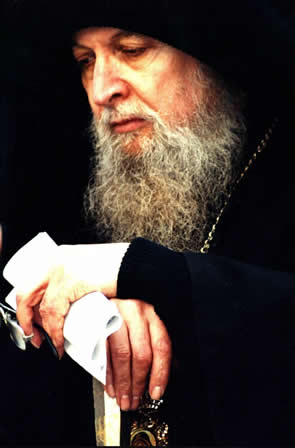Our Changing Paradigms:
 |
 |
 |
![]()
OUR CHANGING PARADIGMS:
SCIENCE AND FAITH: A DIALOGUE
BY:
Archbishop Lazar Puhalo
I have suggested before that we are in the midst of a second "great axial period". [1] Like the first "axial period," [2] the processes and influences of the second axial period in which we find ourselves, can lead closer to, not further from, God. This will happen, however, only if we overcome fundamentalism and extreme right wing religion.
Continuing from my last paper, we will focus this tie on the principle of non-locality.
In the late 1990s, Nicholas Gisin experimented with twin photons — light particles are shown to communicate with each other instantly — and dispelled any notions of "locality" in physical reality. He gave further strength to the theory of non-locality which had been either obvious to or suspected by the earliest quantum physicists. Earlier, in about 1982, Alain Aspect had conducted a series of experiments with atom optics, from which we argue for the essential wholeness of physical reality at its most basic level. [3]
We may posit, therefore, that the perceived division between mind and cosmos is an illusion. From an Orthodox Christian point of view, man was intended by God to be a unifying factor in the universe. This is why some of the holy fathers (St Gregory the Theologian, St. John of Damascus) assert that man is a microcosm of the universe. Man is composed of the same elements as everything in the universe, his mind and body operate in a fashion consistent with the so called "physical laws of nature," but in him the spiritual and intelligent aspects of the universe are combined with the physical, without creating any form of dualism. Angels may be, I would cautiously suggest, "intelligent energy," but man is a complete image of the universe, and created in the image and likeness of the Creator. [4] In man alone, we find a wholeness which unifies every part and aspect of all created things, and presents such a wholeness before God.
This is why the fall of man affected the entire universe, and why Apostle Paul tells us that all creation is being redeemed together with mankind (Rm.8:16-34). Moreover, man alone has the ability to contemplate the universe and to have an awareness of his own presence and place in it.
Orthodox Christianity rejects Platonistic and Gnostic dualism. Consequently, we cannot accept a dualism between the physical and the spiritual in the created universe. There has to be a unity in them, and our concept is that man is the intended point of that unity. Since man is a microcosm of the universe, and the point of unity in the created cosmos, the principle of human evolution should not pose a problem for right-believing Christians. The conflict should arise only from the models of reality formed by the rationalistic juridicialism and Platonistic dualism of medieval scholasticism and its heirs. These "models of reality" recur in reformationist literalism and fundamentalism, blended with the sorrowful legacy of Augustine of Hippo.
Physical reality does not exist only in local points or constructs; the parts are consummated in the whole, while the whole is not simply the sum of the parts. The parts behave as they do because of the whole, and not the reverse. Even with humanity, there is a single nature of all mankind; however each person is gifted with an individual personhood, a "hypostasis." The single human nature consists in what all have in common and which is subject to the so-called "laws of nature." The hypostasis, or individual personhood is added to man be grace. While man comes into a knowledge of God as an individual, the human nature can be known only in the individual, rather than as abstract idea of "humanity," all that he does affects the whole. The principle of non-locality applies to mankind as it does to all of creation. Without our distinct hypostasis, we might be only a member of a herd or tribe of animal. It is this hypostasis that we develop individually, yet within the framework of the human nature. As Paul testifies, "all of creation has been groaning and toiling until now," it was "subjected to infirmity, but not without hope," and is "being set free into the glorious freedom of the children of God." This testifies to the unity of man and the cosmos, and to the fact that the whole universe is affected first by man's fall, and secondly be his redemption.
We are able to contemplate and gradually to comprehend the universe because we are a microcosm of it, and this is why it is so often said that the human brain is "a three pound universe." This in itself testifies to God's intentional creation of man, and of His plan for man's true role in creation. This gives us the proper understanding of the word "sin" — missing the mark or goal. The fall of mankind was not a fall from perfection into depravity, but a fall from the intended use of our energies into an habitual misuse of our energies. Redemption from the bondage into which we have fallen — our bondage to Satan through the fear of death — makes it possible for us to struggle to live a life in Christ, in which our created energies can once more be directed to the mark or goal for which God created us. This is the nature of our salvation: that we become reconciled in a spousal type relationship with God, not that we simply engage in "appropriate" or "moral" behaviour.
Man is separated from God by continually missing the mark. Since God is the only source of life, we are, therefore, separated by our own choices and deeds, from the source of everlasting life. Because we habitually miss the mark, we become subject to the power of death and fall into bondage to "him who holds the power of death" (the evil-one), and thus continue in separation from God. This is why Christ, in the "Lord's Prayer" says, "and deliver us from the Evil-One, NOT deliver us from "evil."
Jesus Christ saves people who have fallen, through their own habitual missing of the mark, from bondage to the power that Satan holds through the fear of death, by breaking that power and overcoming that fear. He became incarnate for this purpose. It is not His death alone, but the entire Incarnate life, of which His death and resurrection were a necessary part, that has made our freedom possible. By recreating in himself or as the Apostle says, Christ "recapitulated all things in Himself .. " (Eph.1:10), He introduced a new power into human nature. This power is bestowed in all people who are willing to receive it, through the Holy Spirit. Those who receive it become re-united with God in Jesus Christ. The old nature ( the "old man" as Paul calls it — Rm.6:6; Eph.4:22; Col.3:9) is driven out by degrees until at last it is expelled altogether, and the redeemed person becomes entirely obedient to the will of God, as our Lord Himself was in His humanity during his ministry on earth. The prisoner is set free from the inside to the out; both his mind and body are changed and he comes to know what freedom is, to desire it and, by cooperating with the Holy Spirit working in him, to break his chains, turn the key and leave the dungeon. Thus, he is freed from the power of sin even if he still slips occasionally. God forgives man as an act of pure love, but the condition of this forgiveness is that he strives not to continue to miss the mark. In the Incarnation Christ became the point of unity in the universe for both the created and the uncreated (Col.1: 15:20 ), and man many imitate this through his unity with God in Jesus Christ and by the indwelling of the Holy Spirit. We do not require the medieval legalistic fiction that Christ died to satisfy God's juridical justice and pay a "just death penalty" for mankind as a "vicarious human sacrifice." In Jesus Christ man may be restored once more to unity with the life of God, and restored to the goal or mark of being a point of unity in the universe itself. Through Jesus Christ, with the help of the Holy Spirit, man once more becomes able to properly use his energies in the fulfillment of God's plan and will.
1. I proposed the theory that we had entered a second axial period with the rise of modern science. In this period the world, man's place in it and the earth's place in the universe, epistemology and all other aspects of human knowledge are being shaped by a "trickle down" from physics, rather that the previous "trickle down" from the major philosophers.
2. Karl Jaspers originated this term and theory, referring to the great era of intellectual development that occurred during the period of about 800-400 B.C. At that time a philosophy of ethics developed, and philosophy began to shape human thought and understanding. Mythologies were interpreted as metaphor and given ethical and moral interpretations.
3. See The Science of Nonlocality and Eastern Approaches to Exploring Ultimate Reality , The Templeton Institute (2002)